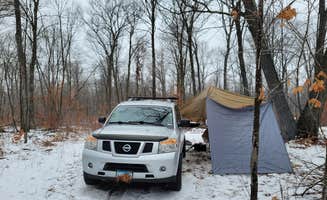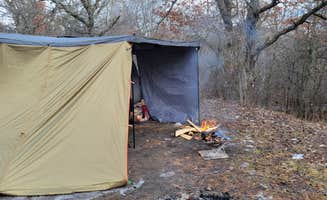Dispersed camping areas near Royalton, Minnesota offer primitive overnight options in largely undeveloped woodland settings. The region sits at the transition zone between northern conifer forests and central hardwood forests, creating diverse ecosystems across public lands. Seasonal weather patterns include heavy summer humidity from July through August, with nighttime temperatures typically 20-30 degrees cooler than daytime highs.
What to do
Wildlife observation: Free camping spots in the Rum River State Forest provide excellent opportunities for animal sightings. "I did hear wolves for the first time. They were howling after sunset. A little creepy, camping alone. But, I don't suspect they'd come too close," reports one Rum River State Forest Dispersed camper. Morning and evening hours yield the most wildlife activity.
Bird watching: The diverse habitats support numerous bird species. "Quiet with lots of different bird sounds," notes one camper at South of Sand Dunes State Forest. Early morning viewing near forest edges produces the best results. Another visitor mentions encountering "a lot of birds as well as deer" during their stay.
Off-road exploration: Numerous side trails branch from main forest roads. Access varies seasonally with some routes requiring proper equipment. "The roads aren't really kept up for the winter. So, you'll want 4 wheel drive and slow and mindful driving," cautions a winter visitor to Rum River. Walking trails provide additional options without vehicle restrictions.
What campers like
Natural solitude: Despite proximity to populated areas, many sites offer genuine seclusion. "I stayed here for 3 days with only one car passing through on the first night. After that, nothing!" shares a camper at Rum River State Forest. The best isolation comes at sites requiring short walks from parking areas.
Proximity to urban centers: The accessibility of free camping near Royalton appeals to weekend warriors. "I love that it's so close to home. I was able to walk in and find an incredible spot to camp and lay in my hammock," writes one Sand Dunes visitor. Most sites require under 90 minutes driving time from major metropolitan areas.
Seasonal variations: Each season brings different camping conditions and experiences. Winter camping offers unique opportunities: "I just cleared the snow, built a heat retaining wall, and set up camp in front of it," explains a December visitor to Rum River. Summer provides easier access but increased insect activity and more fellow campers.
What you should know
Access limitations: Some areas restrict vehicle access. "A lot of the side roads are closed to motor vehicles due to some issues they had a couple years ago but are now taken care of like people dumping," explains one Sand Dunes camper. Before visiting, check current road status through Minnesota DNR resources.
Cell service variability: Connectivity differs significantly between camping areas. At Sand Dunes, expect limited service, though one camper mentions "Weak cell service but manageable." By contrast, at Rum River areas, "The cell service with Verizon is good enough to stream videos and work on your laptop with ease," according to a recent visitor.
Local regulations: Camping durations and regulations can change seasonally. Some areas enforce vehicle restrictions: "Be aware if you have an RV though. I had a county sheriff person tell me it's not lawful to park a trailer and they kicked me out. I called the DNR and they said that wasn't right but I decided to leave anyway," cautions one Sand Dunes visitor.
Tips for camping with families
Wildlife encounters: Prepare children for potential animal sightings. "Stand storks are very protective. Stay away from them. They attack," warns a Lake Placid Watercraft Site visitor. Set clear boundaries about approaching wildlife and establish noise protocols for nighttime hours when predators may be active.
Road safety awareness: Traffic on forest roads creates potential hazards. "This road is pretty busy for a dirt forest road and people FLY down it. Almost got hit a few times walking," cautions a Sand Dunes visitor. Select sites set back from main thoroughfares when camping with children and establish clear road safety rules.
Insect protection: Bugs remain a persistent challenge, particularly for young campers. "The bugs are not great but that's just what you're going to get in an area like this one," notes a Rum River visitor. Pack appropriate repellents, protective clothing, and consider mesh shelters for eating areas during peak mosquito season.
Tips from RVers
Site selection: Most dispersed areas accommodate smaller rigs but require careful positioning. "Most spots are like cutoffs on the sides of the dirt road. They are deep and have plenty of room, though," explains a Rum River Forest camper. Larger vehicles should scout locations before committing to entry points, as turning around may prove difficult on narrow forest roads.
Clearance considerations: Overhead branches create hazards for taller rigs. "We did find one we thought we liked, but branches over hung, and rested on our camper (8ft high) and in fact most sites were shaded," notes one RVer. Travel during daylight hours to better assess clearance issues and carry basic tools for minor branch removal when necessary.
Pull-through availability: Limited pull-through options exist for larger setups. "7/7/1921 pull off sites big have a 37 ft fifth wheel no problem nice an quiet," reports one visitor to Rum River. For most areas, smaller trailers under 20 feet provide the most flexibility, though some sites accommodate larger rigs with careful positioning.



